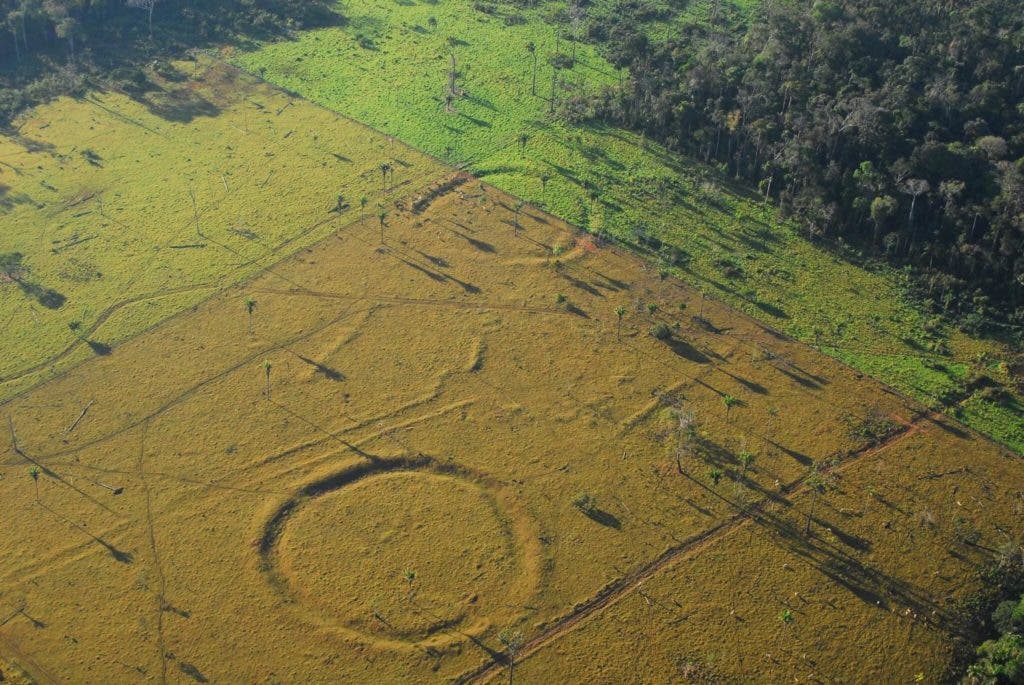Researchers flying drones above the Amazon basin have made a stunning discovery: large, mysterious earthworks built thousands of years ago.

The discovery was made due to an unfortunate circumstance. The structures are located in Acre state in the western Brazilian Amazon and were previously hidden by the thick forest. Modern deforestation has left the landscape open and allowed scientists to see the 450 geometrical glyphs.
Lailson Camelo da Silva, the foreman for a cattle ranch in the far reaches of the Brazilian Amazon, was the first to discover the structures.
“I had no idea that I was discovering the Amazon’s own Stonehenge,” said Mr. da Silva, 65, on a scorching October day as he gazed at the archaeological site located just north of the Equator. “It makes me wonder: What other secrets about our past are still hidden in Brazil’s jungles?”
He informed local archaeologists, who were thrilled to hear about these findings. The research was carried out by Jennifer Watling, a post-doctoral researcher at the Museum of Archaeology and Ethnography, University of São Paulo, while she was studying for a PhD at the University of Exeter. She’s still not sure exactly who built the structures and what purpose they served, but she believes this might force us to re-think what we know about the Amazon forest.
“The fact that these sites lay hidden for centuries beneath mature rainforest really challenges the idea that Amazonian forests are ‘pristine ecosystems`. We immediately wanted to know whether the region was already forested when the geoglyphs were built, and to what extent people impacted the landscape to build these earthworks.”
Using state of the art remote sensing, they were able to chart the glyphs and reconstruct 6000 years of vegetation and fire history around two geoglyph sites. They also took samples on site, analyzing soil from a series of pits dug within and outside of the geoglyphs. From these soils, they analyzed ‘phytoliths’ –rigid, microscopic structures made of silica, found in some plant tissues. The plants take up silica from the soil, and deposit it within different intracellular and extracellular structures of the plant. The phytoliths remain much after the plant itself has decayed. The team also analyzed charcoal quantities, to assess the amount of ancient forest burning and carbon stable isotopes, to indicate how ‘open’ the vegetation was in the past.

They found that humans have been altering the natural environments for millennia, likely developing temporary clearings while the glyphs were built. But they didn’t just cut or burn trees — they were much smarter than that. People transformed their environment by focusing on economically valuable tree species such as palms, creating a kind of ‘prehistoric supermarket’ of useful forest products. This careful practice of agroforestry shaped the evolution of biodiversity in the basin, possibly much more than we anticipated.
But this should not be used as justification for unsustainable logging carried out in the area.
“Our evidence that Amazonian forests have been managed by indigenous peoples long before European Contact should not be cited as justification for the destructive, unsustainable land-use practiced today,” Watling adds “It should instead serve to highlight the ingenuity of past subsistence regimes that did not lead to forest degradation, and the importance of indigenous knowledge for finding more sustainable land-use alternatives”.
“Despite the huge number and density of geoglyph sites in the region, we can be certain that Acre’s forests were never cleared as extensively, or for as long, as they have been in recent years,” she concludes
Journal Reference: Impact of pre-Columbian “geoglyph” builders on Amazonian forests, PNAS, www.pnas.org/cgi/doi/10.1073/pnas.1614359114






